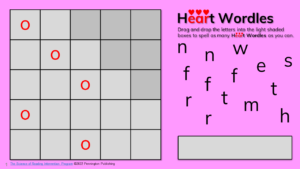Heart Wordles

Heart Wordles Slide Games
Do you love Wordle? For those of you teaching reading intervention, SPED, or ELL classes, here’s a set of 43 FREE Google slide games to help your ages 8-adult students practice Heart Words. Heart Wordles is pretty darn fun!
A Heart Word is a word which includes one or more irregular sound-spellings. Generally, older students have a larger lexical bank than beginning readers, so some of the words used in the game will be new to younger students, but the game may be helpful for them, as well.
Each of the 43 slide games focuses on a particular Heart Word sound-spelling pattern and provides the letters to form 5 words. Teachers should introduce the slide game pattern (the most common ones first) and help students blend example words before assigning students the slide game. Blend the phonetically regular parts and add the parts to learn by heart. New to teaching Heart Words? Check out my article, How to Teach Heart Words.
Not all agree on which sound-spellings are irregular. My selection of the 216 Heart Words in this game is based on sound-spelling patterns, syllables and phonics rules, and the Dolch 220 high frequency word list. I included 59 of the Dolch Heart Words (frequency numbers on the next two slides). Full disclosure: I also included words from lessons and decodables from my own reading intervention programs.
The directions are simple: Drag and drop the letters into the light shaded boxes to spell as many Heart Wordles as you can. I like playing the game whole class with a bit of competition (the first student to create all five words shouts out Heart Wordles! I’ve included a blank text box at the bottom of each slide for a few instructional options: 1. Type (and spell check) each word. 2. Explain the pattern or rule. 3. Write sentences including each Heart Word. 4. ?????0
Heart Wordles Slide Games
https://docs.google.com/presentation/d/1GL-EFFuEhQCoPLFAJYhXP7vn-qeeEZNFY4HAaWMEZMQ/copy
*****
If you like the Heart Wordles Slide Games, you’ll love my reading intervention programs for grades 8-adult:

The Science of Reading Intervention Program
The Science of Reading Intervention Program: Word Recognition includes explicit, scripted instruction and practice with the 5 Daily Google Slide Activities every reading intervention student needs: 1. Phonemic Awareness and Morphology 2. Blending, Segmenting, and Spelling 3. Sounds and Spellings (including handwriting) 4. Heart Words Practice 5. Sam and Friends Phonics Books (decodables). Plus, digital and printable sound wall cards and speech articulation songs. Print versions are available for all activities. First Half of the Year Program (55 minutes-per-day, 18 weeks)
The Science of Reading Intervention Program: Language Comprehension resources are designed for students who have completed the word recognition program or have demonstrated basic mastery of the alphabetic code and can read with some degree of fluency. The program features the 5 Weekly Language Comprehension Activities: 1. Background Knowledge Mentor Texts 2. Academic Language, Greek and Latin Morphology, Figures of Speech, Connotations, Multiple Meaning Words 3. Syntax in Reading 4. Reading Comprehension Strategies 5. Literacy Knowledge (Narrative and Expository). Second Half of the Year Program (30 minutes-per-day, 18 weeks)
The Science of Reading Intervention Program: Assessment-based Instruction provides diagnostically-based “second chance” instructional resources. The program includes 13 comprehensive assessments and matching instructional resources to fill in the yet-to-be-mastered gaps in phonemic awareness, alphabetic awareness, phonics, fluency (with YouTube modeled readings), Heart Words and Phonics Games, spelling patterns, grammar, usage, and mechanics, syllabication and morphology, executive function shills. Second Half of the Year Program (25 minutes-per-day, 18 weeks)
The Science of Reading Intervention Program BUNDLE includes all 3 program components for the comprehensive, state-of-the-art (and science) grades 4-adult full-year program. Scripted, easy-to-teach, no prep, no need for time-consuming (albeit valuable) LETRS training or O-G certification… Learn as you teach and get results NOW for your students. Print to speech with plenty of speech to print instructional components.